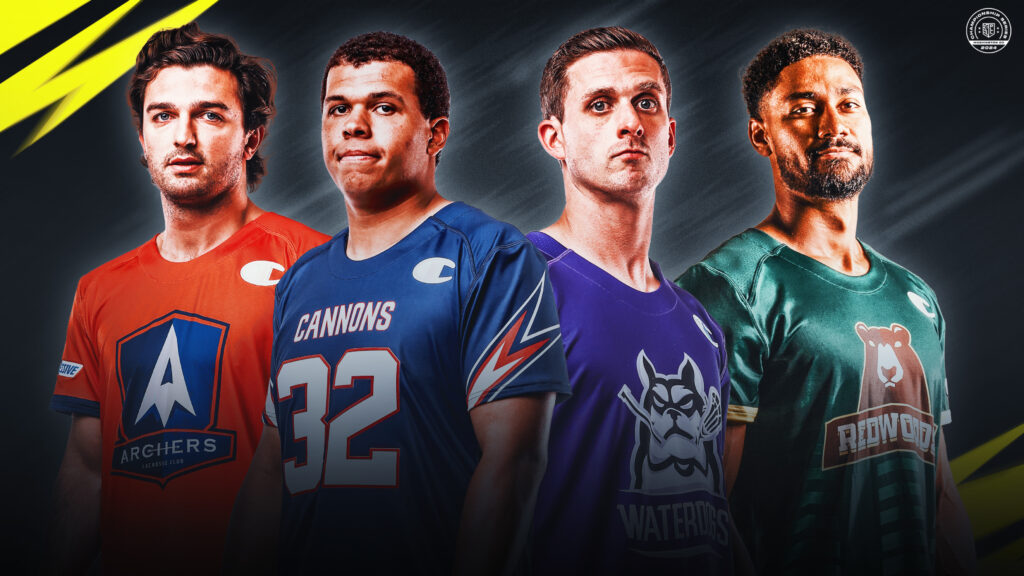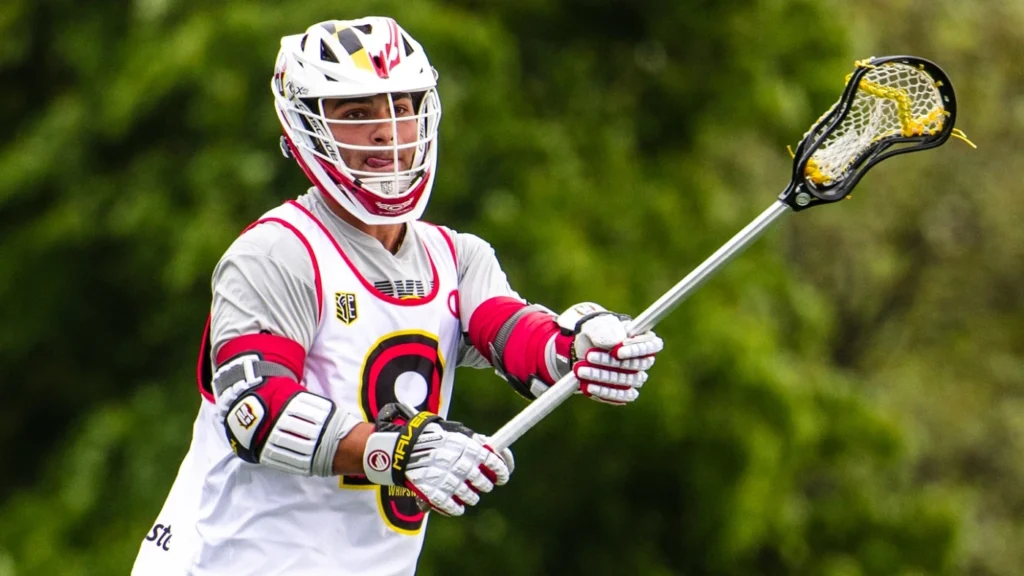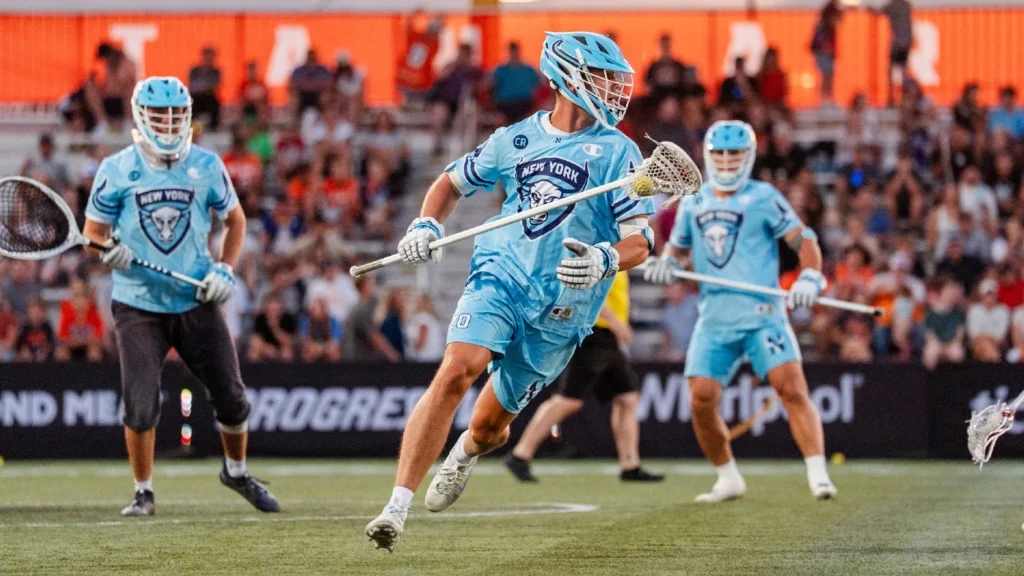
10 Predictions for the 2024 Championship Series
By Joe Keegan
Feb 14, 2024
Time for an annual tradition: 10 Predictions.
Last year was … okay. I correctly predicted Atlas LC leading the tournament in 2-point goals, league-wide 1-point shooting percentage topping 36%, and teams using both goalies.
I was wrong about Logan Wisnauskas leading in goals (he finished four behind Romar Dennis), Jack Concannon leading in save percentage (he was second among starters), Marcus Holman winning MVP, and Archers LC winning it all.
And I was very wrong about 2-point shooting percentage being less than 18% (it was 31.7%), Whipsnakes allowing the lowest GAA (they allowed the highest), and Jay Carlson scooping 5+ GBs per game (the ball was barely on the ground; nobody had more than 3 per game).
We’ve seen this format now. We have a better idea of what to expect. I need to be better than 3/10 – but also want to take some swings. So, here are my 10 predictions for the 2024 Championship Series:
1. Teams will attempt 15+ 2-pointers per game
The 13-yard 2-point arc was a gamechanger in 2023. And it was underutilized.
Remember Opening Night? We had barely seen sixes played at this level – nevermind sixes with a 2-point arc. That first game between Atlas LC and Whipsnakes LC was a whirlwind. It was lacrosse on Fast Twitch. Atlas shot 7-for-12 (58.3%) from beyond the arc. And we all knew that was only the tip of the 2-point iceberg. Twenty-four hours later, Atlas doubled their volume from deep, shooting 11-for-25 (44.0%).
Atlas wasn’t the only team to increase their 2-point output. Across the league there were 8.8 attempts per team from deep on Opening Night; by the time Sean Sconone and Chrome LC were soaked in Andre champagne, that number had jumped to 11.4.
Then-interim head coach Steven Brooks set a goal for 2-point attempts per game. Their floor was around 15 attempts per game.
Atlas was an anomaly in ‘23. But my guess is their strategy will be the rule in ‘24.
It has to be. The shots are too valuable to pass up. League-wide shooting percentage was 31.7% from 2-point range and 46.1% from 1-point range. The expected value of a 2-point shot (0.63 points) is 1.38x higher (!!!) than the expected value of a 1-point shot (0.46).
Trading ones for twos is a losing strategy in a game with alternating possessions. Sure, it worked for Chrome LC – barely. It took Atlas’s worst 2-point shooting performance of the week (27.8%) for Chrome to eek out a 1-point win.
We know 2-point attempts will increase. But by how much? Fifteen per team per game (~33.3% of all shots) feels like a fair guess.
2. 1-point shooting percentage will eclipse 50%
If 2-point volume increases, then 1-point volume will decrease … and I think teams will only “settle” for 1-pointers when there’s a mismatch.
Think of the X attackmen playing: Rob Pannell (California Redwoods), Asher Nolting (Boston Cannons), Michael Sowers (Philadelphia Waterdogs), Kieran McArdle (Philadelphia), Jules Heningburg (California), Ryan Drenner (Boston), Matt Kavanagh (Boston).
Last year’s tournament was full of versatile personnel to a fault. Versatility isn’t overrated – but it’s an overused term. There is only one Zach Currier. Most other two-way players are jacks of all trades and masters of none.
Coaches were more concerned with dressing players who wouldn’t hurt them on defense. The few offensive stars there dominated. Grant Ament shot 68.8% from inside the arc last year!
Pannell, Nolting, Sowers, McArdle, Heningburg, Drenner, and Kavanagh are all matchup nightmares on an island.
3. Scoring will increase YoY
This prediction is a function of Prediction #1, Prediction #2, and Chrome LC not returning to the tournament.
Chrome’s gameplan was to beat the crap out of teams. Most teams approached sixes as if it were basketball; Chrome played like it was hockey. As Billy Football pointed out, the 2023 Chrome roster had the most mass. Their defensive efficiency (opponents only scored on 35.0% of possessions) was head and shoulders above the rest of the league (41.4%).
These four rosters have less mass and more playmaking. The coaches have real film to study. Some of these coaches even have real experience coaching sixes. We’re starting to learn what constitutes a quality shot in sixes. Expect subbing patterns and offensive schemes to evolve in a way that leads to more points.
4. Asher Nolting will lead the tournament in assists
… or else he’ll shoot 75%.
If Nolting is dodging at X with Holman, Drenner, Matt Campbell, and Chris Aslanian perched atop the arc – who do you help from?
Maybe defenses decide that the 1-pointer by Nolting is worth less than the stepdown from that firing squad, so they don’t slide at all. We’ll see. It’ll be fun to watch how willing defenses are to slide to X in general. Some of the most aggressive defenses in ‘23 sent slides to alley dodges – and leaked the original on-ball defender upfield for outlets. (More on that in a minute.)
But sliding to X?! That leaves you vulnerable above the arc and slows down your collective first step in transition. Goalies might prefer a contested close-range shot over another bruising time-and-room try.
If teams send help, then Nolting will carve them up as a passer like he’s done his entire career. And if they don’t? He’ll bully his way to layups and dunks like this.
(Sidenote: My least favorite part of sixes is that it leaves no time for celebrations and Ryan Boyle’s “FREEZE IT RIGHT HERE!” breakdowns. I hope that Nolting still celebrates in some capacity. Keep the camera on him after he subs off. I want to see the “too small” gesture!)
5. The Redwoods goalies will combine for 5+ assists
Outlet passes are critical with (1) a shorter field and (2) no offsides. Fast breaks are not 4-on-3s in sixes; they are 1-on-0s. Those breakaway looks are unlocked most often following clean saves.
Teams scored on 44.1% of possessions that started with a clean save – better than possessions following turnovers (41.5%), wide shots (39.6%), messy saves (38.4%), and goals against (36.4%). How you end your previous defensive possession is one of the biggest drivers of offensive efficiency (and vice versa).
Jack Kelly and Tim Troutner are two of the best at controlling their own rebounds. Since 2019, Kelly (39.3%) and Troutner (38.6%) lead all goalies in this tournament in clean save rate. The Redwoods should be studying the looks Chrome was able to create off Sconone’s saves (and even some off his goals against) by leaking the on-ball defender upfield as they slide.
6. Ryan Aughavin will average 5+ PPG
The Utah Archers are the only returning team in the tournament, but they bring back less continuity than you might think. Four runners – Ryan Aughavin, Ryan Ambler, Matt Moore, and Jon Robbins – are back.
Aughavin led the team in 2-point shooting percentage (4-for-8, 50.0%) and 1-point shooting (7-for-10, 70.0%). But he only took 4.5 shots per game. Those are rookie numbers. You gotta pump those up. For context, three different players on Atlas averaged 8+ shots.
Without Grant Ament (left knee), the Archers need a playmaker to emerge. Ambler and Cole Williams are strong supporting cast members. (That’s an understatement re: Ambler.) Ronan Jacoby and Nate Solomon have highlight-reel potential as re-dodgers and finishers.
Aughavin and Moore feel like the most likely candidates to quarterback the offense. In field rules, I’d build my offense around Moore. This week, though, I’d see if Aughavin can take a leap in a larger role. He has shown flashes of a young Max Seibald. It’s time to let Auggie loose. Let’s see more of this.
7. Colin Kirst will lead the tournament in save percentage (and win Kirst of the Week)
Elite goaltending has been a common denominator between championship sixes teams. Brett Dobson was lights out for Canada in The World Games; Sean Sconone hit another level in the 2023 Championship Series.
Whichever goalie gets hot will give their team a major advantage. Jack Kelly (California Redwoods) has the most sixes experience. At 6-foot-6 Matt DeLuca (Philadelphia Waterdogs) has the biggest frame.
Colin Kirst (Boston Cannons) is the best from 13 yards-and-out. He has stopped 76.8% of shots from would-be 2-point range in his career (no other goalie in the tournament is above 67%). And teams will need to test him from beyond the arc to keep up with the Cannons offense. This isn’t the boldest prediction, but give me Kirst to lead the tournament in save percentage (and win Kirst of the Week).
8. The Redwoods will lead the tournament in scores per game
There are tons of catch-and-shoot threats from 2-point range. But Romar Dennis is one of the few who can create his own 2-pointers.
He’s a unique weapon. We saw Atlas use Romar as a screener both off-ball…
Romar pin down screen for a 2-pointer. I counted four (4!!!) pick assists for Romar. Nobody wants to help from him above or near the arc. pic.twitter.com/E44mz1FaX3
— Joe Keegan (@joekeegs) February 23, 2023
… and on-ball …
Another Romar pick assist. No switch or even a hedge from his defender. His gravity is real. pic.twitter.com/0rggtI60c7
— Joe Keegan (@joekeegs) February 23, 2023
Expect to see much more of that from John Grant Jr.’s offense. The Romar-Sergio Perkovic pick-and-roll might turn into the tournament’s most dangerous action. Their gravity above the arc will slow down slides to Pannell, Heningburg, Kevin Rogers, Nakeie Montgomery, Ricky Miezan, and Ryan Tierney.
The pieces around Romar are different. Chris Gray (54.5%), Bryan Costabile (50.0%), and Jake Carraway (54.5%) all shot 50%+ from 2-point range on 10+ attempts. These Redwoods don’t have that range – but they have way more 1-on-1 winners. The ‘23 Atlas relied on Romar to create shots; the ‘24 Redwoods will have multiple offensive initiators.
I’ll take this team offense to lead the tournament. However…
9. There will be a new Golden Stick Award winner
I don't know who it'll be. But there's too much talent across these four teams to predict a repeat.
McArdle and Holman are two of the best scorers of all-time. Both have 13-yard range -- though I don't know how much time either will spend above the arc, and you need to hit twos to win this award.
Jake Carraway shot 6-for-11 (54.5%) from 2-point range in last year's tournament with a groin injury. He was burying stepback twos. He'll be full strength this week, sprinting around screens, in what should be an incredibly efficient offense.
Matt Campbell shot 28.6% from 13+ yards as a rookie. Chris Aslanian has 2-point range with both hands. I could see either of them emerging as a candidate in an unselfish Cannons offense. If I had to pick between them, I'd go with Aslanian because of his ability (and willingness) to shoot on the run.
My two darkhorses: Aslanian or Carraway.
10. The Philadelphia Waterdogs will beat the Boston Cannons in the Finale
The Waterdogs have all the pieces. Sowers and McArdle are the toughest one-two dodging punch in the entire league. Two fearless, certified bucket getters. “PICK FOR SOWERS WITH WHOEVER DOESN’T HAVE 91” might be the single best play in lacrosse. Once Sowers earns a short-stick matchup, it’s over. And they don't need to waste any time picking for switches this week.
Their defenders are gritty. Charlie Hayes (22.6% shooting percentage allowed as the closest defender) and Jake Higgins (22.9%) begin their 2024 Exposed Elbow Award campaigns now. Christian Scarpello can turn defense into offense.
DeLuca’s 6-foot-6 frame will be an X-factor. He cuts down angles even on a flat arc. What if he steps toward shooters like his teammate Dillon Ward? Brian Phipps had success on a high arc in ‘23; with uptempo play and tons of possessions, good goaltending might be more about stealing a few rather than stopping most.
And head coach and general manager Andy Copelan will be prepared for every scenario. The Waterdogs are one of the best out-of-timeout offenses in the league. Every time they need a 2-pointer, they create a quality look. Jake Carraway’s move to midfield in ‘23 added a new element to his game – with his shot, two-man games from this area are dangerous.
The young pups have potential, too. Jeff Conner was a two-way weapon at Virginia. Kyle Borda is a big midfielder with 2-point range. Jack Traynor scored 49 points (32G, 17A) last spring for Penn State while wearing the #16 jersey in honor of Connor Darcey. All three were picked up entering training camp, but struggled to crack the league’s most loaded midfield. They’ll be foaming at the mouth for this opportunity.
This roster has the right balance of veterans and youth. Of offense and defense. Of dodgers and 2-point shooters. They thrive in tight games, finding new ways to win every week. There’s a case for every team – the Redwoods’ 2-point shooting, the Cannons’ unselfish offense, the Archers’ organization and experience – but if I had to pick a champion, I’d take the Waterdogs.





